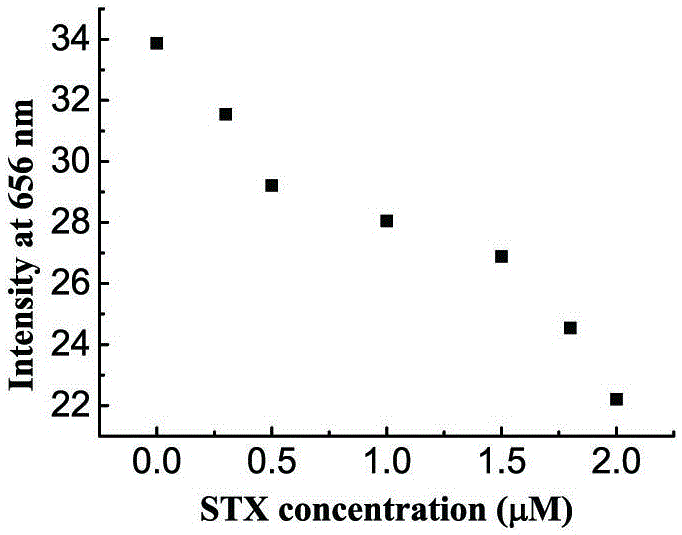Method for detecting saxitoxin on basis of embedded dye and DNA interaction
A technology for saxitoxin and a detection method, which is applied in the field of detection and research of saxitoxin, can solve the problems of high detection cost, complicated optical signal sequence and ineffective effect, and difficult to obtain instruments, and achieves simple detection method, overcoming Effects of Immobilization and Detection Platform Construction Complexity
- Summary
- Abstract
- Description
- Claims
- Application Information
AI Technical Summary
Problems solved by technology
Method used
Image
Examples
Embodiment 1
[0023] Firstly, 1 μM DNA was dissolved in 10 mM Tris-HCl buffer solution with pH=7 and quenched, then saxitoxin was added to the Tris-HCl buffer solution to interact with DNA, and the interaction time was 25 min. After the time for the interaction is up, add 1 μM fluorescent violet to the Tris-HCl buffer, wait for 25 minutes, use a fluorescence spectrophotometer to measure the fluorescence spectrum, and calculate the stone by comparing the peak at 652 nm of the measured spectrum with the standard curve. Toxin concentration of saxitoxin.
Embodiment 2
[0025] First, 1 μM DNA was dissolved in 10 mM Tris-HCl buffer at pH=7 and quenched, then saxitoxin was added to the Tris-HCl buffer to interact with DNA, and the interaction time was 35 min. After the time for the interaction is up, add 1 μM fluorescent violet to the Tris-HCl buffer, wait for 35 minutes, use a fluorescence spectrophotometer to measure the fluorescence spectrum, and calculate the stone by comparing the peak at 652 nm of the measured spectrum with the standard curve. Toxin concentration of saxitoxin.
Embodiment 3
[0027] Firstly, 1 μM DNA was dissolved in 10 mM Tris-HCl buffer solution with pH=7 and quenched, and then saxitoxin was added to the Tris-HCl buffer solution to interact with DNA, and the interaction time was 30 min. After the time for the interaction is up, add 1 μM fluorescent violet to the Tris-HCl buffer, wait for 30 minutes, use a fluorescence spectrophotometer to measure the fluorescence spectrum, and calculate the stone by comparing the peak at 652 nm of the measured spectrum with the standard curve. Toxin concentration of saxitoxin.
PUM
 Login to View More
Login to View More Abstract
Description
Claims
Application Information
 Login to View More
Login to View More - Generate Ideas
- Intellectual Property
- Life Sciences
- Materials
- Tech Scout
- Unparalleled Data Quality
- Higher Quality Content
- 60% Fewer Hallucinations
Browse by: Latest US Patents, China's latest patents, Technical Efficacy Thesaurus, Application Domain, Technology Topic, Popular Technical Reports.
© 2025 PatSnap. All rights reserved.Legal|Privacy policy|Modern Slavery Act Transparency Statement|Sitemap|About US| Contact US: help@patsnap.com


